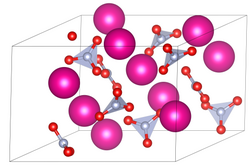
| |
 Unit cell of rubidium nitrate | |
| Names | |
|---|---|
| IUPAC name Rubidium nitrate | |
| Identifiers | |
| CAS Number | |
| 3D model (JSmol) | |
| ChemSpider | |
| ECHA InfoCard | 100.032.767 |
| EC Number |
|
| PubChem CID | |
| RTECS number |
|
| CompTox Dashboard (EPA) | |
InChI
| |
SMILES
| |
| Properties | |
| Chemical formula | RbNO3 |
| Molar mass | 147.473 g/mol |
| Appearance | White hygroscopic solid |
| Density | 3.11 g/cm |
| Melting point | 310 °C (590 °F; 583 K) decomposes |
| Boiling point | 578 °C (1,072 °F; 851 K) |
| Solubility in water | 44.28 g/100 mL (16 °C) 65.0 g/100 mL (25 °C) |
| Magnetic susceptibility (χ) | −41.0·10 cm/mol |
| Refractive index (nD) | 1.524 |
| Structure | |
| Crystal structure | trigonal |
| Space group | P31 |
| Lattice constant | a = 10.474 Å, c = 7.443 Å |
| Lattice volume (V) | 707.2 Å |
| Hazards | |
| Occupational safety and health (OHS/OSH): | |
| Main hazards | Oxidant |
| NFPA 704 (fire diamond) |
 |
| Flash point | Non-flammable |
| Lethal dose or concentration (LD, LC): | |
| LD50 (median dose) | 4625 mg/kg (rat, oral) |
| Related compounds | |
| Other anions | Rubidium sulfate Rubidium chloride |
| Other cations | Lithium nitrate Sodium nitrate Potassium nitrate Caesium nitrate |
| Except where otherwise noted, data are given for materials in their standard state (at 25 °C , 100 kPa).
| |
Rubidium nitrate is an inorganic compound with the formula RbNO3. This alkali metal nitrate salt is white and highly soluble in water.
Properties

Rubidium nitrate is a white crystalline powder that is highly soluble in water and very slightly soluble in acetone. In a flame test, RbNO3 gives a mauve/light purple colour.
Uses
Rubidium compounds have very few applications. Like caesium nitrate, it is used in infrared radiation optics, in pyrotechnic compositions as a pyrotechnic colorant and as an oxidizer, e.g. in decoys and illumination flares although it is rarely used in fireworks to produce a red-violet colour. It is also used as a raw material for preparation of other rubidium compounds and rubidium metal, for manufacture of catalysts and in scintillation counters.
Production
RbNO3 can be prepared either by dissolving rubidium metal, its hydroxide or carbonate in nitric acid.
- RbOH + HNO3 → RbNO3 + H2O
- Rb2CO3 + 2 HNO3 → 2 RbNO3 + CO2 + H2O
- 2 Rb + 2 HNO3 → 2 RbNO3 + H2
References
- ^ W. Lenk, H. Prinz, A. Steinmetz,"Rubidium and Rubidium Compounds" in Ullmann's Encyclopedia of Industrial Chemistry, 2010 Wiley-VCH Verlag GmbH & Co. KGaA, Weinheim. doi:10.1002/14356007.a23_473.pub2
- Jutta Pohl, Dieter Pohl, Gunadi Adiwidjaja (1992). "Phase Transition in Rubidium Nitrate at 346 K and Structure at 296, 372, 413 and 437 K". Acta Crystallographica Section B. B48 (2): 160–166. doi:10.1107/S0108768191013459.
{{cite journal}}: CS1 maint: multiple names: authors list (link)
| Rubidium compounds | |
|---|---|
| Salts and covalent derivatives of the nitrate ion | ||||||||||||||||||||||||||||||||||||||||||||||||||||||||||||||||||||||||||||||||||||||||||||||||||||||||||||||||||||||||||||||||||||||||||||||||||||||||||||||||||||
|---|---|---|---|---|---|---|---|---|---|---|---|---|---|---|---|---|---|---|---|---|---|---|---|---|---|---|---|---|---|---|---|---|---|---|---|---|---|---|---|---|---|---|---|---|---|---|---|---|---|---|---|---|---|---|---|---|---|---|---|---|---|---|---|---|---|---|---|---|---|---|---|---|---|---|---|---|---|---|---|---|---|---|---|---|---|---|---|---|---|---|---|---|---|---|---|---|---|---|---|---|---|---|---|---|---|---|---|---|---|---|---|---|---|---|---|---|---|---|---|---|---|---|---|---|---|---|---|---|---|---|---|---|---|---|---|---|---|---|---|---|---|---|---|---|---|---|---|---|---|---|---|---|---|---|---|---|---|---|---|---|---|---|---|---|
| ||||||||||||||||||||||||||||||||||||||||||||||||||||||||||||||||||||||||||||||||||||||||||||||||||||||||||||||||||||||||||||||||||||||||||||||||||||||||||||||||||||